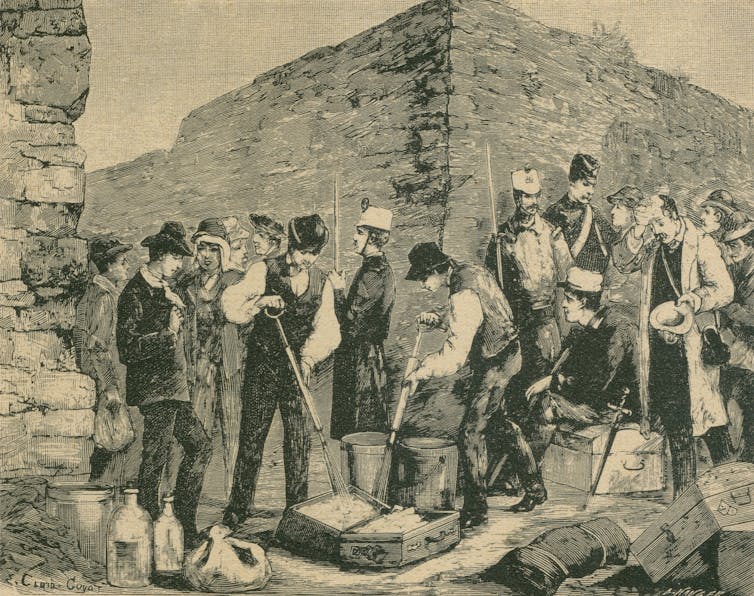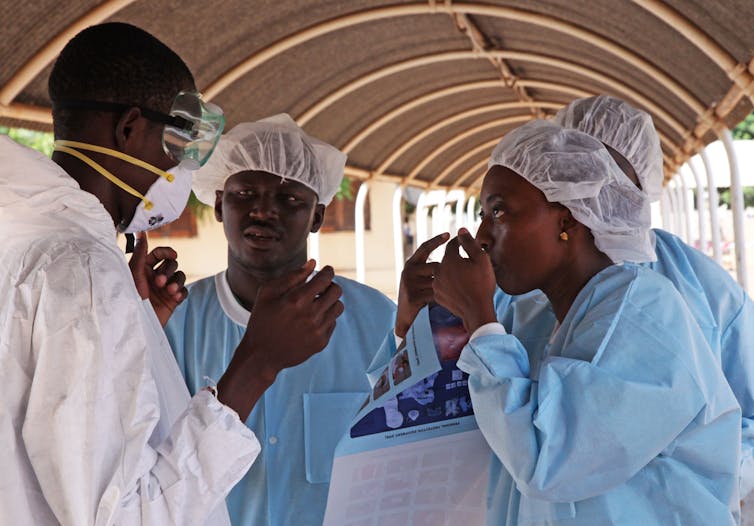Stop calling the novel coronavirus outbreak the “Wuhan coronavirus,” and start getting comfortable with “COVID-19.” That’s the World Health Organization’s recommended name for the disease.
While identifying a new disease by its place of origin seems intuitive, history demonstrates that doing so can harm the people who live there. Consequences can include economic distress, as tourists withdraw, investment cools down and solidarities between people weaken. Linking a specific disease with a specific place can lead to discrimination and stigmatization and avoidance of a town or village.
As a historian of public health and modern Africa, I study the politics of infectious diseases and the importance of understanding the cultural contexts of epidemics and responses to them. Past epidemics underscore the social and public health consequences of how people talk about a disease’s origins.
A long tradition of naming by place
Tagging a place when identifying a disease has a long history.
In the 19th century, as global trade and mobility allowed cholera to spread worldwide from its origins in the Ganges Delta, the disease quickly became known as “the Asiatic cholera.” That label persisted for decades, implicitly blaming an entire continent for a disease that can spread anywhere as a function of poor sanitation.

For Europeans and Americans of the time, Asia was an exotic, distant somewhere else. Distinguishing the disastrous illness of cholera as “Asiatic” fit with the racialized, imperial views that denigrated the intelligence and the cultures of non-white populations globally and justified colonial overrule. It also helped justify more stringent quarantine measures and travel restrictions for people read as “Asian” and not European. Muslim pilgrims en route to Mecca from southern Asia, for instance, were subject to different rules than European troop ships traveling the same routes.
Ideas about disease changed after the late 19th century, when scientists could use new laboratory techniques to link specific pathogens – bacteria, parasites, and later on, viruses – to specific diseases. Sometimes, this gave a scientific name to an age-old problem, such as “consumption” becoming the medical entity tuberculosis.
But these new techniques also allowed researchers to correlate pathogens with particular locales. Naming an illness after a place quickly became the norm.
So Rift Valley Fever, caused by a virus in the Bunyaviridae family, got its name from an area of colonial Kenya where it was first reported.
The Hantaviruses are linked to the Hantan River area of South Korea where Dr. Ho-Wang Lee first identified the virus.
Ebola virus disease (EVD) got its popular name from a river near the village in the modern nation of Democratic Republic of Congo (formerly Zaïre) where U.S. and European scientists identified that pathogen.
Focusing on a specific place creates something particular from something that could have happened anywhere. There’s nothing peculiarly distinctive about Lassa village in Nigeria, compared to any other village five or 50 miles away. Lassa was just the first place where a white missionary’s death drew the attention of authorities. And yet, in the aftermath of that moment, as “Lassa fever” came to identify a fearsome hemorrhagic fever, the town of Lassa became a shadow of its former self.
Focusing on the wrong things
In the short term, close associations between places and diseases can stigmatize the sick, as well as influence perceptions of risk for people both nearby and distant.
An outbreak of a serious and deadly respiratory and hemorrhagic disease reported in the U.S.’ Four Corners region in 1993 was tagged by the press as a “Navajo flu.” People in the area assumed incorrectly that the disease was directly contagious and highly localized to the Navajo Nation.
Associating this alarming new disease specifically with the Navajo Nation had a chilling effect on reporting illness to medical authorities because of fear of stigma. In the end, officials named the new hantavirus that caused that particular outbreak Sin Nombre, which means “without a name” in Spanish.
Understanding disease ecology and patterns of transmission at a point of origin are important for biologists and epidemiologists. But permanently naming a disease for a specific place serves to keep public attention on the moment of origin – the “spillover” case or known outbreak of an epidemic.
Focusing on how an “emerging” disease originally reached human populations can come at the expense of clear messaging about who is at risk of infection or how to prevent the disease in an ongoing epidemic. What’s more, that outbreak moment is often less relevant for a general public looking to stay healthy or public health practitioners trying to control a person-to-person epidemic.

Building blame into a name
Affixing place to disease also puts a spotlight on specific people, which matters for how a wider public associates a population’s perceived culture, foodways or activities with a disease.
These kinds of stereotypes arose, for instance, around Ebola virus disease in 2014-15, erroneously blaming some people for a wider problem.
Early conversations about EVD, marked as particularly African with its name, focused on eating “bushmeat,” a term from the colonial era to describe meat that people hunt, rather than buy in a market. Talking about “bushmeat” allowed people to characterize those suffering from EVD as primitive or exotic. It also implied that people were responsible for bringing this disease into circulation because of what they ate or how they lived.
In fact, the wider spread of EVD in 2014-15 had everything to do with underfunded health systems in the affected nations and nothing to do with what people ate.
A similar process is unfolding now, with rumors that Wuhan’s “wet markets” are the culprits of zoonotic spillover, where viruses jump from animals to humans. Scientists don’t yet know how relevant Wuhan’s live-animal markets truly were for this global epidemic, although they do know that viruses jump from animals to humans (and back again) frequently. Wuhan’s historic position as a national high-speed rail and commercial hub is likely to be far more important for the wider dissemination of COVID-19 than where and how people shopped and ate.
Get used to COVID-19
Public health officials and scientists have come to understand the potentially harmful repercussions of associating place and disease names – for both the immediate public health response and the long-term economic and social future of a given place. In 2015 WHO announced its official guidelines to avoid the practice.
In the past weeks, as the novel coronavirus has dominated the news and spread around the world, there’s been vigorous debate about what to call it. It’s important for both a popular understanding of risk and prevention, as well as for global solidarity with the heavily affected population of Wuhan, to get used to saying “COVID-19” and to insist that others do the same.
After all, Spain had nothing specific to do with the so-called “Spanish influenza,” as the devastating H1N1 influenza pandemic of 1918-19 was popularly known for decades. They just reported it first.
[You’re too busy to read everything. We get it. That’s why we’ve got a weekly newsletter. Sign up for good Sunday reading. ]
Post a Comment